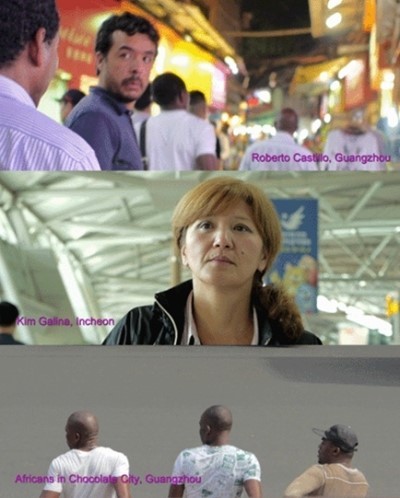In Bong Joon-ho’s 2006 film “The Host,” its gigantic, amphibious monster ― which emerges after an American military pathologist dumps bottles of formaldehyde into Seoul’s Han River ― does not move forward. The ferocious creature stays by the river, as if it is trapped, even after kidnapping a teenage girl.
Scholar and filmmaker Kim So-young thinks director Bong’s monster is a symbol of South Korea’s geographically isolated condition ― the country is practically an island as its division with North Korea blocks its land route to the continent ― in spite of its globalized economy. Her latest film and media art project, which is currently on display at Ilmin Museum of Art in central Seoul, tries to expand the definition of Korean cinema, both metaphorically and geographically.
Kim, who currently teaches cinema studies at Korea National University of Arts, has been researching the Korean diaspora, particularly ethnic Koreans living in central Asia and Russia. Her installation on show, titled “Strangers in Open Cities,” features some footage from her ongoing documentary project, which follows the lives of marginalized individuals in different cities. One of those is a restaurant owner named Alex, who was born in Uzbekistan to ethnic Korean parents and moved to Korea’s Ansan, Gyeonggi Province, as an adult for work opportunities.
 |
Filmmaker and scholar Kim So-young (Park Hae-mook/The Korea Herald) |
“When Alex first came to Ansan, his boss refused to pay him on time eight times,” Kim said during an interview with The Korea Herald. “He was financially struggling, but decided to volunteer at an NGO that supports ethnic Koreans who moved to Korea from Central Asia and Russia. For him, Korea is his parents’ country, and although he wasn’t born here, he has that sense of belonging which makes him think he’s ‘returned’ to his home.”
One of Kim’s research achievements is the discovery of ethnic Korean filmmakers in Central Asia, some of whom fled Pyongyang in the 1950s, and their films. Most ethnic Koreans in Central Asia are descendents of some 180,000 Koreans who were living in the Soviet Union near its border with today’s North Korea in the 1930s. In 1937, as part of Stalin’s ethnic cleansing campaign, most of that population of Koreans in the Russian Far East were forced to move to then-unpopulated areas of today’s Central Asia, traveling some 5,900 kilometers.
 |
“Strangers in Open Cities,” a 3-channel video installation by Kim So-young |
One ethnic Korean filmmaker in Kazakhstan is Son Lavrentii, who is also a writer. His subject matter includes the 1937 deportation and the way it lives on in the memories of ethnic Koreans in Kazakhstan.
“I don’t think we should approach ethnic Koreans in these regions by asking questions such as, ‘Do they know how to speak Korean?’ or ‘How much of Korean tradition do they still practice now?’” said Kim. “Their experience and films are like a gift to us, which gives us an opportunity to see the lives of others, whose history has a great relevance to our own. They open a door for us to understand the bigger, unexplored world and history.”
Some of the ethnic Koreans in Kazakhstan are former North Koreans who studied cinema at a prestigious film school in Moscow as international students in the 1950s. In 1958, dozens of them made an open announcement, expressing their objection to Kim Il-sung’s dictatorship. They then filed for asylum in the Soviet Union, which was granted under one condition: The students had to live apart from each other, in different cities across the nation. The students eventually moved to Central Asia together. Only two of them, in their 80s now, are alive in Kazakhstan today.
“They worked as cameramen in the Soviet Union,” Kim said. “One of the reasons they moved to Central Asia is because they knew there was a community of ethnic Koreans there. They’d be able to get kimchi there too.”
Kim’s definition of Korean cinema includes works by directors like Lavrentii, ethnic Korean-Chinese filmmaker Zhang Lu and Japanese filmmaker Yoichi Sai, whose father is an ethnic Korean, on top of those by Park Chan-wook and Na Woon-gyu (1902-1937). Zhang’s 2007 film “Hyazgar (Desert Dream),” which was screened in competition at the Berlin International Film Festival in the same year, deals with a North Korean refugee woman who makes a living by selling kimchi in a border town between Mongolia and China. Sai’s critically acclaimed 2004 film “Blood and Bones,” on the other hand, follows the life of a Korean man who moves from the nation’s southernmost island of Jeju to Japan’s Osaka and eventually becomes an abusive, merciless loan shark.
“The question is, how are we going to respond to these films?” said Kim. “And how are we going to do that with a sense of responsibility?”
The scholar also serves as one of the co-directors of the annual International Women’s Film Festival in Seoul. For the festival’s upcoming editions ― this year’s opens in May ― Kim said she hopes to collaborate with and support more women filmmakers in China.
“There aren’t that many NGOs in China, and Chinese documentaries are what fill in for the role (of NGOs),” Kim said. “Chinese documentaries are some of the most politically and aesthetically provocative films today. And they need international support.”
Kim’s installation work will be on display at Ilmin Museum of Art until June 8. Her ongoing documentary project will be premiered at this year’s EBS International Documentary Festival slated to open in August.
By Claire Lee (
dyc@heraldcorp.com)









